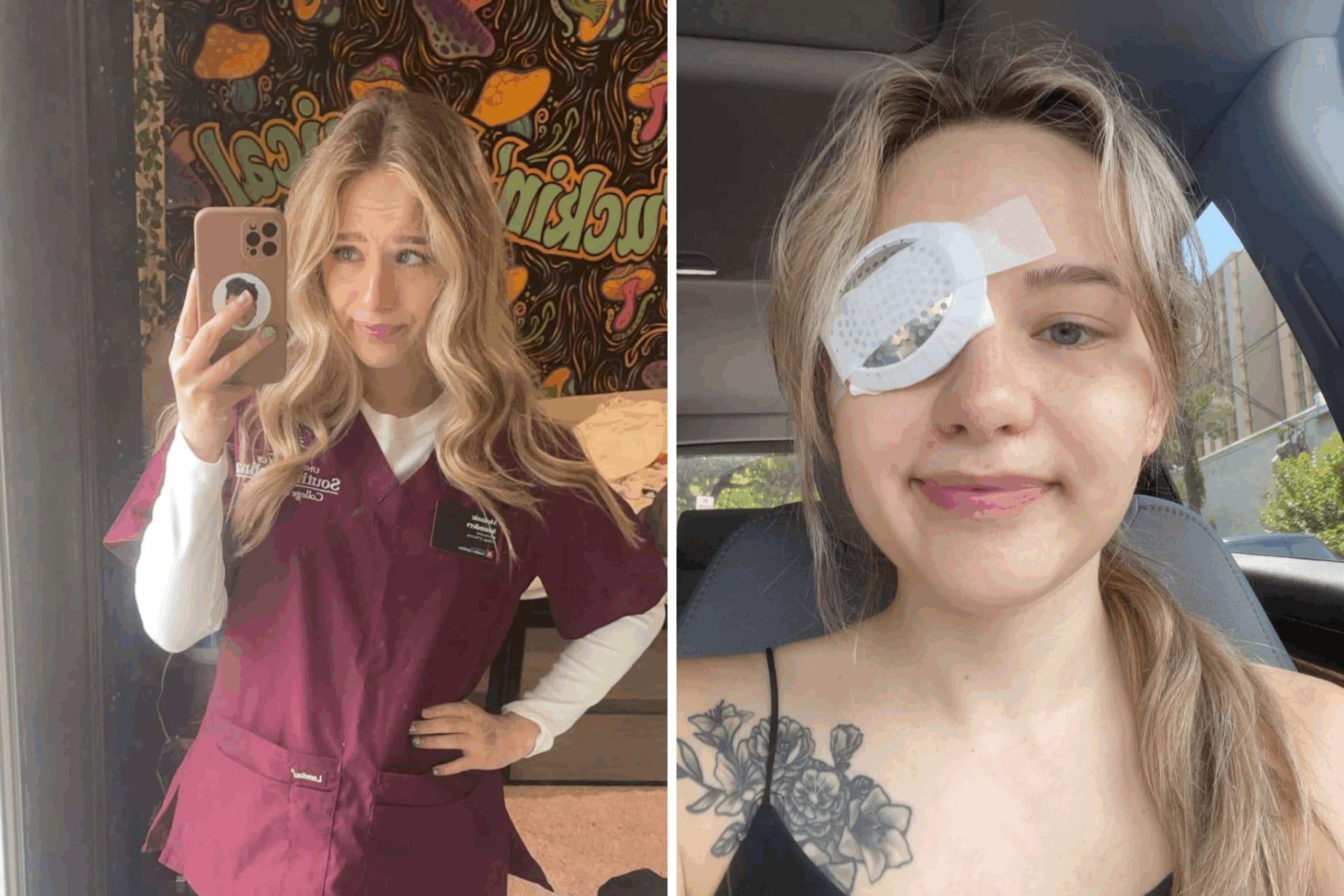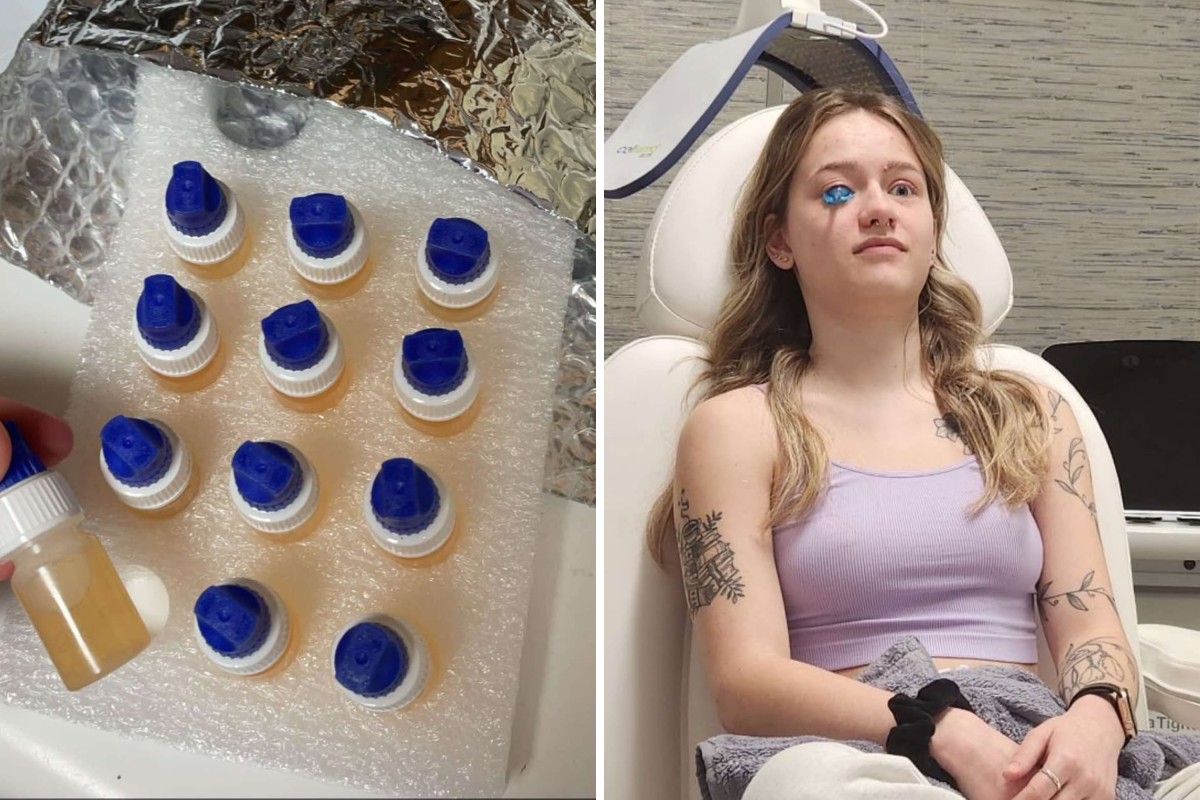
At 22, I never expected to need help from my parents, be unable to drive, complete my nursing studies—or even read a book. But that’s been my life for the past three years since I was diagnosed with a condition that means I have to apply eye drops every 10 minutes.
My name is Melanie Saunders. I live with lacrimal gland failure, corneal neuralgia, and meibomian gland dysfunction—also known as dry eye.
These diseases are complicated. I’ve been presented with a couple of different terms and disease names that are pretty much interchangeable, like ocular surface disease, an umbrella term that encompasses basically anything and everything that could go wrong with your eye, specifically your cornea.
For me, corneal neuralgia symptoms feel like burning and stinging, like bleach in my eye, or sunscreen or shampoo. I feel that sensation 24/7. The lacrimal gland failure also causes some burning, as well as grittiness—raw, dry friction, like my eye is raw and exposed. It feels like wind is constantly blowing in my eye.
I didn’t get diagnosed until I was 19 because there’s not much preventative testing done in the eye care world. I went to my eye doctor every single year, telling them my eyes were so dry my contact lenses hurt, but they told me I was fine, because they only ever tested for my oil production. My lacrimal gland was shutting down over the years, and they just didn’t know.
I have tested negative for everything doctors can think of to cause my symptoms, including autoimmune diseases and inflammatory markers. They can’t currently pinpoint a cause for my condition, but have theorized that I may have an underlying autoimmune disease that we don’t know about yet.
In my case, symptoms started showing up for me at age 12, but I wasn’t diagnosed until I was 19, and I completely stopped producing tears. While my eyes had always been painful and dry, this happened overnight—I woke up one morning with my eyes covered in cuts and abrasions.
I can still produce tears when I cry: these are reflex tears, composed of just salt and water. But they are incredibly painful—just like pouring salt over the cuts and abrasions on my eyes. But I don’t have basal tears, the tears released constantly throughout the day that moisturize your eye, and include nutrients for your corneal nerves.
Instead, I use eye drops made from my own diluted blood—as it closely mimics the composition of a basal tear, and are used to treat a variety of ocular surface diseases. These prevent the cornea from deteriorating—if this happened, the nerves could completely die, and I wouldn’t be able to feel any pain. And if that wasn’t treated, I would go blind.
Melanie Saunders
I have to use eye drops every 10 minutes, every day, because I need to manually produce lubrication to avoid friction when blinking, and I take the blood drops 20 to 30 times a day.
My blood eye drops need to stay refrigerated, so if I’m out and about, or traveling or flying, I carry them in a cooler that keeps them cold for as long as 24 hours. I sleep with ointment on my eyes, and an eye mask over them, but I still wake with the pain several times a night.
I can’t drive, I can’t read a hand-held book or look at screens for very long. I can’t do online school or online work. I’m very limited in what I can do.
My focus right now is on pain management and my mental health, on just how to stay alive with this disease, how to find little bits of quality of life, because I’m pretty much entirely homebound.
I am lucky that I have a support system and family are willing and able to take care of me, because if I didn’t, I would be homeless. I would end up dead one way or another, because I wouldn’t be able to work to feed myself. I wouldn’t be able to take care of myself.
It’s part of why I think people don’t understand how severe dry eye can be, because we don’t understand those little kinds of nuances.
There’s a lot of emphasis in the world right now on things that are afflicting young people and keeping them from working, and this is just one thing that’s going completely unspoken about. But this disease is leaving people my age and younger homebound, partially bedbound, completely unable to work. We’re not blind, we’re not trained in Braille. We have 24/7 excruciating pain.
There’s something really devastating about the lack of awareness—it is almost impossible to get disability for this. Some doctors might just use the term dry eye, because that’s what’s most well-known. And I can only imagine if I didn’t have this disease, if I was somebody sitting in a disability office and I picked up someone’s paperwork, and saw the disease they have is dry eye, if I didn’t know any better I’d be like, “Dry eye? You’ve got to be kidding. There’s no way this person is disabled.”
For my situation, to preserve as much moisture in my eye as possible I had to permanently surgically close the tear ducts that drain anything from the eye—this is standard medical treatment for ocular surface disease, blocking the tear ducts either permanently or temporarily. And that, in itself, causes a huge host of problems, because allergens get trapped in my eye, and that causes more severe allergic responses and inflammation.
But rinsing my eyes out with preservative-free saline also washes away all the good stuff—any oil I’ve been blinking into my eye, or my blood eye drops, all get washed away.

Melanie Saunders
As a kid, I always had dry symptoms in my eyes. But they really began when I started wearing contact lenses. They would just dry up throughout the day. I would have to cause some sort of pain, or stare into bright sunlight, to cause my eyes to produce tears. And still, my contacts would dry up and get stuck to my eye. While I don’t know the root cause of my illnesses, I believe it’s something genetic—because so many people wear contact lenses, or use eyelash extensions, and never have any problems.
Any treatments for me now are band aids at best. I’ve traveled the country, I’ve done all the available treatments. I’ve done experimental treatments. So right now, I’m just waiting on new medicine.
I started a support group for young people with chronic dry eye, and 300 people joined without advertising the group at all.
Who knows how many people have dry eye that don’t know of the group, who don’t have Facebook or a phone, because this disease limits most people from using a phone or using a screen.
I talk about life with these eye diseases on my TikTok account, @melbrynn, where I answer questions as best as I can to try and educate people on the seriousness of “dry eye,” and what this term really entails.
Because the awareness just isn’t there. It’s very rare, so we don’t have the funding, and we desperately need new treatments. It’s not that nobody’s thinking of what could be done, it’s not that there aren’t answers, it’s just that there’s no money for it right now.
I hope my raising awareness can help change that.
